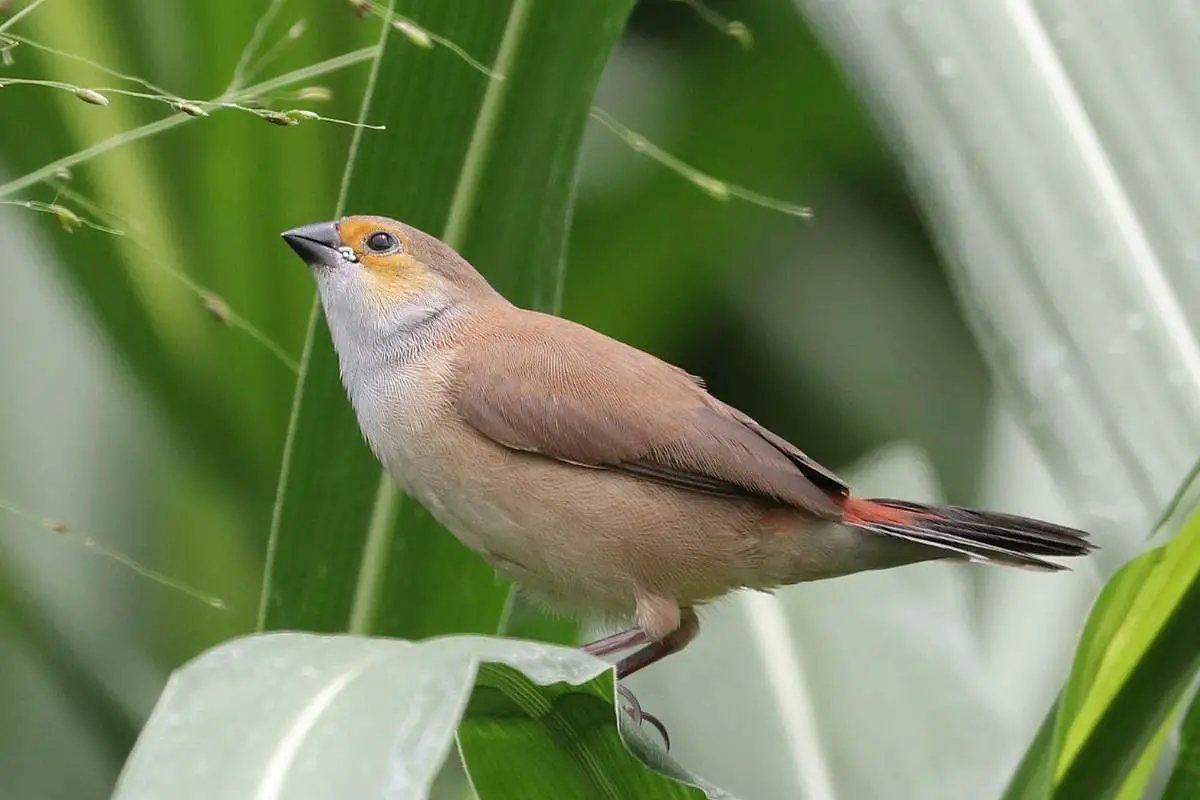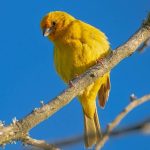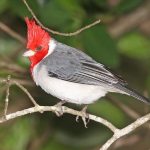Common Name: Orange-cheeked Waxbill
Scientific Name: Estrilda melpoda| Size | Diet | Range in Hawaii | Status in Hawaii |
|---|---|---|---|
| 4 in. | insects, including mealworms, termites, ant eggs and aphids | Hawaiian islands | least concern |
The Orange-cheeked waxbill is one of the birds that you can find in Hawaii. These are brightly colored little birds that will definitely catch the attention of anyone. These birds were only introduced recently, but they were found to thrive on one of Hawaii’s islands.
Let’s look at some of the facts about the Orange-cheeked waxbill and see how they live in the wild.
Orange-cheeked waxbill

Scientific Name: Estrilda melpoda
Appearance
The orange-cheeked waxbill is a small African bird that was introduced to Hawaii. Their wings are mostly light brown, and they have bright orange cheeks that extend all the way up to their rosy bill.
Their undersides are light gray, and their tails are black or brown with a gray or white underside. These birds stand about 4 inches tall, with medium-length wings and rounded tails. Their young chicks are paler in color compared to adults.
Diet
This small bird’s diet consists primarily of grass seeds, but it also consumes other types of seeds and bugs. They have been observed eating these seeds directly from grass panicles and even hanging on the stems to harvest the ripe seeds.
They frequently consume insects as part of their diet during the breeding season. Aside from their regular seed diet, you’ll notice them eating termites, gnats, mealworms, aphids, and ant eggs.
Behavioral Traits
These birds are very sociable and can be seen in large flocks in the wild, usually in groups of 6-15, but sometimes in groups of 50-60. They’re also known to get along with other species, but they can be aggressive during the breeding season.
Males of this species can be heard singing more frequently than females. Their music is weak, high-pitched, and squeaky. They also have a variety of melodies that include metallic trills, nasal ‘zee’, and an alarm call that sounds like ‘tsit, tsit’.
Breeding
The Orange-cheeked waxbill breeds throughout the year, but are seen breeding most during the warm months of spring. They build their nests on the ground among tall grasses, using clumps of grass to blend in with the surroundings. White feathers are used to make pillows for the eggs that these birds will lay.
These birds are monogamous, and males will court females by dancing up and down and singing while carrying a grass stalk. They lay 3 to 6 eggs per season, which they incubate for 13 days. After 23 days from the time of hatching, the chicks will leave the nest and become independent.
Habitat

These waxbills can be found in coastal thickets, cassava fields, savannahs, edges of swamps, and even abandoned farms. They reside in areas with plenty of tall grasses, and a dry surface, which is close to water sources. This is where these birds hunt for food and build their nests.
Native range
The orange-cheeked waxbill is native to western and central Africa, including Nigeria, Cameroon, Puerto Rico, Rwanda, and the Gambia. They’re typically found in these countries’ dry savannahs, open grasslands, and gardens.
These birds were transported by slave trade ships to multiple countries. They’ve also been introduced in other countries, including Puerto Rico, Taiwan, Singapore, Spain, California, Guadeloupe, Martinique, and Texas.
Hawaii
The birds were brought to other countries as well as the southeast Hawaiian Islands. They were discovered in the 1960s on Oahu and in the 1990s on Maui. However, the number of these waxbills on O’ahu decreased in the 2010s, with the last six individuals discovered in Kaneohe, Hawaii.
The first five birds observed on Maui were near Pu’unene in 1989 and thrived more than those on O’ahu. They gradually increased in the 1990s and 2000s, reaching a peak of more than 50 individuals on Kealia Pond.
These species can be found from Kihei to Lahaina, as well as in the Waihe’e wetlands of Kahalui. However, competition with common waxbills may be one of the causes of their future decline.
Conservation status
The IUCN classifies orange-cheeked waxbills as Least Concern. They’re common in their native range in Africa and are thriving in the Hawaiian islands, though in smaller numbers than in their native range.
Interesting Facts
1. They’re diurnal birds
The orange-cheeked waxbill is diurnal, which means it’s active during the day. They’re active in the morning and spend most of their time foraging for food in the underbrush.
2. They’re highly social species
Orange-cheeked waxbills are highly social birds that frequently mingle with other bird species. They have also been observed preening with other adult birds and getting along well with birds of similar size and temperament. Although they live in large flocks, these birds prefer to nest alone.
3. You can frequently find these birds in captivity
These birds make excellent pets because they’re easy to care for and can be very affectionate. They also have a reputation for being extremely friendly, frequently approaching their owners in search of food or attention.
4. A group of finches is called ‘charm’
Because orange-cheeked waxbills are finches, a flock of these birds is known as charm, as well as “company” and “trembling.”
5. Because of the red color of their bills, they’re known as waxbills
The waxbill name is given to birds in the Estrildidae family because of the red color of their bills, which resembles the color of sealing wax.
Frequently Asked Questions
How can you tell which is a male or female orange-cheeked waxbill Finch?
Males and females of this species have the same color, but females’ colors are duller. Males also have a darker orange-yellow stripe near the vent than hens, and they sing to attract females.
How many years does orange cheeked waxbill live?
In the wild, these birds have a lifespan of seven to eight years, but in captivity, they can live for more than ten years if properly cared for.




